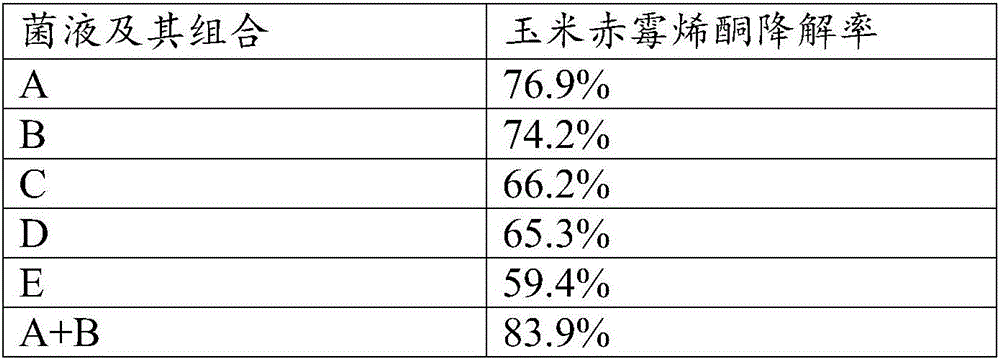Composite microbial inoculant for degrading zearalenone and preparation method thereof
A technology of zearalenone and compound bacterial agents, applied in the direction of microorganism-based methods, biochemical equipment and methods, bacteria, etc., can solve the problems of nutrient loss, low detoxification rate, time-consuming and labor-intensive problems, and achieve cost-effective Low, will not cause secondary pollution, and improve the effect of degradation rate
- Summary
- Abstract
- Description
- Claims
- Application Information
AI Technical Summary
Problems solved by technology
Method used
Image
Examples
preparation example Construction
[0020] A preparation method for a composite microbial agent for degrading zearalenone, comprising:
[0021] S1. Culture Paenibacillus, Rhodococcus, Pseudomonas putida, Micrococcus luteus and Acinetobacter baumannii respectively to obtain Paenibacillus bacteria liquid, Rhodococcus bacteria liquid, Pseudomonas putida bacteria liquid, Micrococcus luteus and Acinetobacter baumannii bacteria liquid.
[0022] Among them, Paenibacillus sp. comes from the strain preservation number DSM 11730, Rhodococcus sp. comes from the strain preservation number NCIB 9160, Pseudomonas putida comes from the strain preservation number ATCC 17514, Garcinia cambogia Micrococcus luteus is from strain deposit number NCIB 8166, and Acinetobacter baumannii is from strain deposit number ATCC 15308.
[0023] Specifically, the Paenibacillus and Micrococcus luteus are inserted into the Paenibacillus medium and the Micrococcus luteus medium respectively, and cultured at a temperature of 27-35° C. for 45-50 ho...
Embodiment 1
[0038] In the present embodiment, a preparation method of a composite microbial agent for degrading zearalenone comprises:
[0039] First, insert Paenibacillus from strain preservation number DSM 11730 into a Paenibacillus culture medium consisting of 8 g of peptone, 13 g of beef extract, 14 g of sodium chloride, and 1000 mL of distilled water, at a pH of 7.0 and a temperature of 28°C conditions for 48 hours.
[0040] The rhodococcus from the strain preservation number NCIB 9160 was inserted into the rhodococcus medium consisting of 3 g of glucose, 3 g of yeast powder, 9 g of malt extract, 1.5 g of calcium carbonate and 1000 mL of distilled water, and cultured at a temperature of 28 ° C for 48 Hour.
[0041] Pseudomonas putida from the strain preservation number ATCC 17514 was inserted into a mixture consisting of 18 g of glucose, 2.5 g of DL-2-amino-2-thiazoline-4-carboxylic acid, 4 g of corn steep liquor, 2 g of urea, and 1 g of sodium chloride. , 0.05 g of manganese sulfa...
Embodiment 2
[0054] In the present embodiment, a preparation method of a composite microbial agent for degrading zearalenone comprises:
[0055] First, insert Paenibacillus from the strain preservation number DSM 11730 into a Paenibacillus culture medium consisting of 12g of peptone, 17g of beef extract, 17g of sodium chloride and 1050mL of distilled water, at a pH of 7.2 and a temperature of 35°C conditions for 48 hours.
[0056] The rhodococcus from the strain preservation number NCIB 9160 was inserted into the rhodococcus medium consisting of 5 g of glucose, 5 g of yeast powder, 11 g of malt extract, 2.5 g of calcium carbonate and 1050 mL of distilled water, and cultured at a temperature of 30 ° C for 50 Hour.
[0057] Pseudomonas putida from the strain preservation number ATCC 17514 was inserted into a mixture consisting of 22 g of glucose, 3.5 g of DL-2-amino-2-thiazoline-4-carboxylic acid, 6 g of corn steep liquor, 4 g of urea, and 2 g of sodium chloride. , 0.15 g of manganese sulf...
PUM
 Login to View More
Login to View More Abstract
Description
Claims
Application Information
 Login to View More
Login to View More - R&D
- Intellectual Property
- Life Sciences
- Materials
- Tech Scout
- Unparalleled Data Quality
- Higher Quality Content
- 60% Fewer Hallucinations
Browse by: Latest US Patents, China's latest patents, Technical Efficacy Thesaurus, Application Domain, Technology Topic, Popular Technical Reports.
© 2025 PatSnap. All rights reserved.Legal|Privacy policy|Modern Slavery Act Transparency Statement|Sitemap|About US| Contact US: help@patsnap.com


